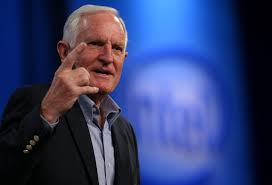
Craig R. Barrett (born August 29, 1939) is an American materials scientist and business leader best known for serving as Intel’s 4th chief executive officer (1998–2005) and chairman (2005–2009). A former Stanford professor, Barrett helped turn Intel’s manufacturing organization into a repeatable, global advantage and guided the company through the late-1990s PC boom, the dot-com downturn, and the early 300 mm fab era. He is also a prominent advocate for STEM education and digital inclusion.
Early life & education
-
Birthplace: San Francisco, California, USA
-
Education: B.S., M.S., and Ph.D. in Materials Science & Engineering, Stanford University
-
Academia: Joined the Stanford faculty in the 1960s; co-authored the widely used text The Principles of Engineering Materials (with Tetelman & Nix). His research and teaching centered on metallurgy, defects in solids, and mechanical behavior of materials.
Intel career timeline (high level)
-
1974: Joins Intel to strengthen process development and manufacturing.
-
1980s–early 1990s: Rises through manufacturing and technology leadership roles; becomes a key proponent of rigorous, metrics-driven production (“Copy Exactly!” discipline).
-
1993–1997: Chief Operating Officer; later President, focusing on execution across Intel’s global fab network.
-
1998–2005: Chief Executive Officer. Oversees expansion in Oregon, Arizona, Ireland, Israel, and the transition to 300 mm wafers; launches platform initiatives (e.g., Centrino).
-
2005–2009: Chairman of the Board. Continues external advocacy on education and competitiveness; retires in 2009.
Strategy & contributions
-
Manufacturing as a moat: Barrett institutionalized factory replication and process control so that yields and performance were consistent across sites—vital for quick ramps of new nodes.
-
Process technology transitions: Drove the move from 200 mm to 300 mm wafers and early copper/low-k introductions, helping reduce unit cost while increasing output.
-
Platform thinking: Backed the Centrino mobile platform (CPU + chipset + Wi-Fi) that reset Intel’s mobile trajectory in the early 2000s.
-
Global footprint: Expanded high-volume manufacturing and assembly/test across multiple countries, diversifying risk and tapping regional talent.
-
Public policy voice: Became one of industry’s louder voices on education, immigration, and R&D investment as pillars of national competitiveness.
Notable products & bets during/around his tenure
-
Pentium III / Pentium 4 (NetBurst): Aggressive frequency scaling that later ran into power/thermal walls—an instructive misstep that set the stage for Intel’s later pivot to performance-per-watt.
-
Itanium architecture: A long-range bet for 64-bit servers; significant ecosystem investment but limited commercial impact.
-
Centrino (2003): A rare case of successful platform branding that accelerated Wi-Fi adoption in laptops.
-
300 mm fabrication: Early high-volume use brought major cost and capacity leverage versus competitors still ramping 200 mm.
Leadership style
-
Execution-first: Data-driven, factory-floor oriented, with a reputation for “no excuses” operational discipline.
-
People & culture: Emphasized candid debate (the Intel style), clear metrics, and fast decision-making.
-
External engagement: Comfortable on the global stage, tying Intel’s interests to broader themes of education and innovation policy.
Challenges & criticisms
-
NetBurst & Itanium: Critics argue these consumed years of engineering focus with limited long-term payoff; supporters note that disciplined execution kept Intel’s volumes and cash flow strong through difficult cycles.
-
Post-dot-com restructuring: Led cost controls and portfolio pruning after 2001; painful but kept capex aimed at core process leadership.
Post-Intel activities
-
Education & digital inclusion: Chaired or supported initiatives aimed at improving math/science education and expanding internet access in developing regions.
-
Boards & advisory roles: Served on corporate and nonprofit boards; with his spouse, Barbara Barrett (a former U.S. Secretary of the Air Force), funded major education programs—most prominently Barrett, The Honors College at Arizona State University.
Selected acknowledged quotes
(Commonly attributed to Craig Barrett in speeches/interviews; wording may vary slightly by venue.)
-
“Innovation and education are the twin engines of economic growth.”
-
“You can’t save your way to prosperity; you invest your way there—primarily in people and R&D.”
-
“Moore’s Law isn’t a law of physics; it’s a statement about human ingenuity and relentless engineering.”
-
“The best jobs go where the best-educated workers are. That’s not politics—that’s economics.”
-
“If you want predictable results at scale, copy exactly—measure, verify, and then replicate.”
-
“Competitiveness is a choice: invest in talent, reward risk-taking, and build what you design.”
Timeline (condensed)
-
1939: Born in San Francisco.
-
1960s–1974: Stanford professor; publishes foundational materials-science work.
-
1974: Joins Intel in technology development.
-
1993–1997: COO → President.
-
1998–2005: CEO during PC boom, dot-com bust, and 300 mm ramp.
-
2005–2009: Chairman; retires from Intel.
-
2010s–present: Focus on education, innovation policy, and philanthropy.
Legacy
Craig Barrett’s legacy is the industrialization of Intel’s manufacturing advantage—turning leading-edge process technology, factory replication, and ruthless execution into a durable competitive edge. While several high-profile architectural bets underdelivered, his tenure preserved Intel’s scale, seeded later pivots toward efficiency, and amplified the company’s voice on the global stage of education and innovation.
Also Reed:











Jensen Huang Drops Donald Trump Truth Bomb on Joe Rogan Podcast